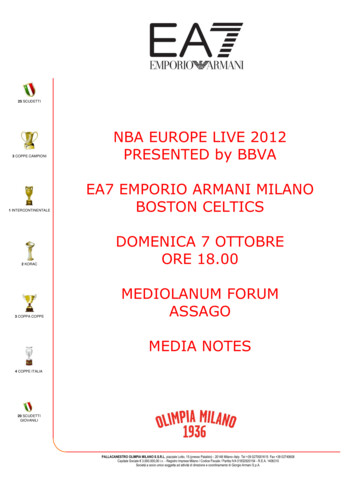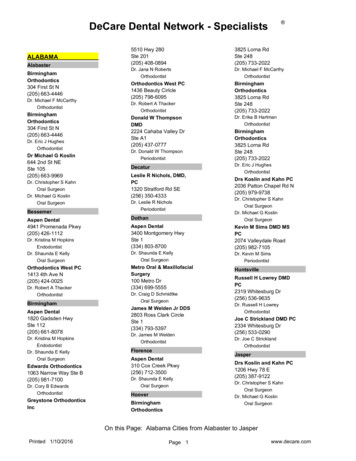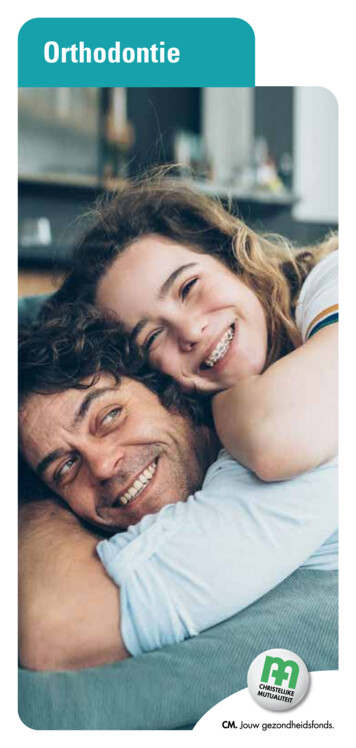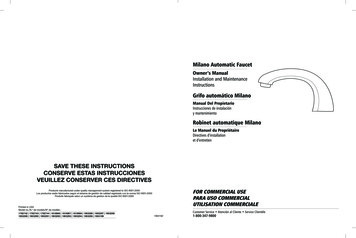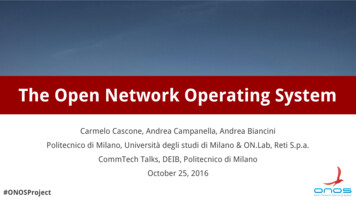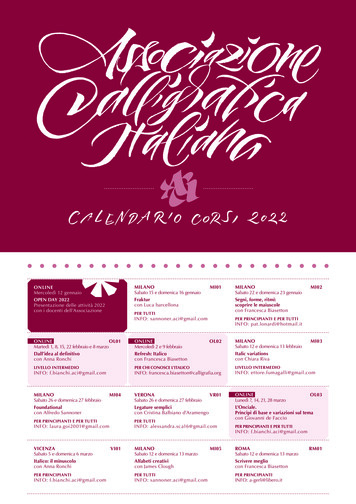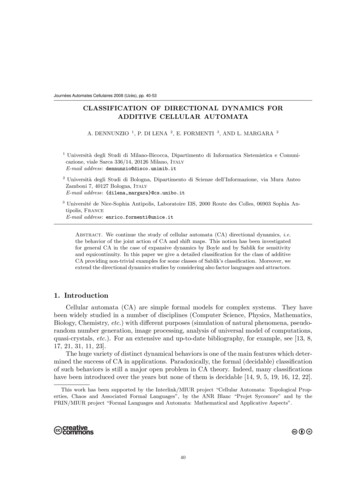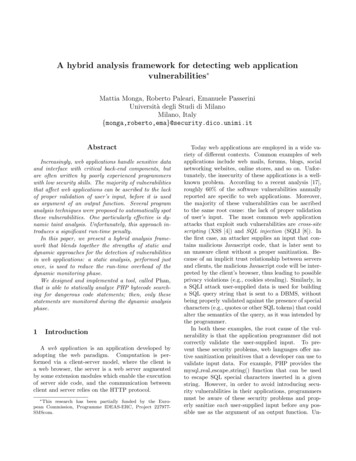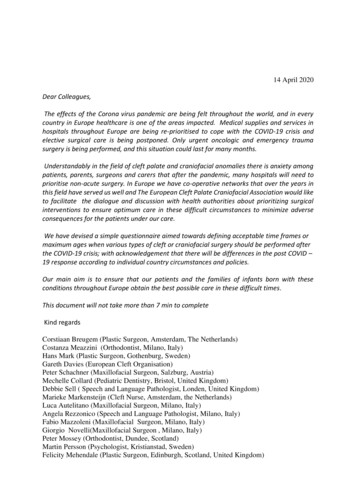
Transcription
14 April 2020Dear Colleagues,The effects of the Corona virus pandemic are being felt throughout the world, and in everycountry in Europe healthcare is one of the areas impacted. Medical supplies and services inhospitals throughout Europe are being re-prioritised to cope with the COVID-19 crisis andelective surgical care is being postponed. Only urgent oncologic and emergency traumasurgery is being performed, and this situation could last for many months.Understandably in the field of cleft palate and craniofacial anomalies there is anxiety amongpatients, parents, surgeons and carers that after the pandemic, many hospitals will need toprioritise non-acute surgery. In Europe we have co-operative networks that over the years inthis field have served us well and The European Cleft Palate Craniofacial Association would liketo facilitate the dialogue and discussion with health authorities about prioritizing surgicalinterventions to ensure optimum care in these difficult circumstances to minimize adverseconsequences for the patients under our care.We have devised a simple questionnaire aimed towards defining acceptable time frames ormaximum ages when various types of cleft or craniofacial surgery should be performed afterthe COVID-19 crisis; with acknowledgement that there will be differences in the post COVID –19 response according to individual country circumstances and policies.Our main aim is to ensure that our patients and the families of infants born with theseconditions throughout Europe obtain the best possible care in these difficult times.This document will not take more than 7 min to completeKind regardsCorstiaan Breugem (Plastic Surgeon, Amsterdam, The Netherlands)Costanza Meazzini (Orthodontist, Milano, Italy)Hans Mark (Plastic Surgeon, Gothenburg, Sweden)Gareth Davies (European Cleft Organisation)Peter Schachner (Maxillofacial Surgeon, Salzburg, Austria)Mechelle Collard (Pediatric Dentistry, Bristol, United Kingdom)Debbie Sell ( Speech and Language Pathologist, Londen, United Kingdom)Marieke Markensteijn (Cleft Nurse, Amsterdam, the Netherlands)Luca Autelitano (Maxillofacial Surgeon, Milano, Italy)Angela Rezzonico (Speech and Language Pathologist, Milano, Italy)Fabio Mazzoleni (Maxillofacial Surgeon, Milano, Italy)Giorgio Novelli(Maxillofacial Surgeon , Milano, Italy)Peter Mossey (Orthodontist, Dundee, Scotland)Martin Persson (Psychologist, Kristianstad, Sweden)Felicity Mehendale (Plastic Surgeon, Edinburgh, Scotland, United Kingdom)
Alexander Gaggl (maxillofacial Surgeon, Salzburg, Austria)Christine van Gogh (ENT surgeon, Amsterdam, The Netherlands)Petra Zuurbier (Orthodontist, Amsterdam, the Netherlands)Siegmar Reinart (Maxillofacial Surgery, Tuebingen, rrent situation as a result of coronavirus: To what extend has your cleft/craniofacial centre been affected by Coronovirus?(Martin’s suggested sliding 0 – 100 per cent bar)Are you currenty still undertaking cleft and/or craniofacial surgery?Yes/No/SomeCLEFT SURGERY:How many months delay from your protocol would be acceptable for primary cleft lipsurgery? 3 months6 months9 months12 monthsNo priority / relevance in time for closureI’m not involved in this type of surgeryCommentsPrimary palate closure (including the soft palate) should be performed before the age of 9 months
12 months15 months18 months24 monthsNo priority / relevance in time for closureI’m not involved in this type of surgeryCommentsOnce it is decided that placement of middle ear tubes is mandatory, how many months delayfrom your protocol would be acceptable ? 3 months 6 months 9 months 12 months No priority / relevance in time for surgery I’m not involved in this type of surgery CommentsOnce it is decided that children with Robin sequence and obstructive breathing problems donot respond to positional change and surgery is necessary, should this be done within Immediately (as soon as possible) 4 weeks 8 weeks No priority / relevance in time for surgery I’m not involved in this type of surgery CommentsOnce it is decided to do secondary cleft lip surgery, this should be performed within 3 months 6 months 12 months No priority / relevance in time for surgery I’m not involved in this type of surgery CommentsOnce it is decided to do a palatal fistula closure, this should be performed within 3 months 6 months 12 months No priority / relevance in time for closure I’m not involved in this type of surgery Comments
Secondary speech improving surgery for nasal speech is mandatory based on the Speechand Language Therapist’s recommendation and agreed with the surgeon. What is the latesttime that VPI surgery should be performed following this recommendation: 3 months 6 months 12 months No priority / relevance in time for surgery I’m not involved in this type of surgery CommentsIf patients with an alveolar cleft are ready for bone grafting ( possibly with orthodonticpretreatment), how many months delay from your protocol would be acceptable? 3 months 6 months 12 months No priority / relevance in time for closure I’m not involved in this type of surgery CommentsOnce it is decided to do secondary cleft nose surgery, this should be performed within 3 months 6 months 12 months No priority / relevance in time for surgery I’m not involved in this type of surgery CommentsOnce it is decided to do a le Fort osteotomy, with orthodontic pretreatment, thisshould be performed within 3 months6 months12 monthsNo priority / relevance in time for surgeryI’m not involved in this type of surgeryComments
Could you please describe briefly from your opinion how the Coronavirus will affect yourcleft and/or craniofacial treatment at your workplace - short and long term. .Is there any support your workplace might need to mitigate the effects of the Coronavirus? .Microtia careOnce it is decided to do a microtia ear reconstruction, this should be performed within 3 months 6 months 12 months No priority / relevance in time for surgery I’m not involved in this type of surgery CommentsOnce it is decided that a patients needs BCD surgery, this should be performed within 3 months 6 months 12 months No priority / relevance in time for surgery I’m not involved in this type of surgery CommentsCraniofacial conditionsCraniosynostosisOnce it is decided to do a craniosynostosis correction (without signs of intracranial pressure)by using springs/endoscopic strip removal, this should be performed before the age of
6 monthsI’m not involved in this type of surgeryI will decide to perform an open procedureCommentsOnce it is decided to do a craniosynostosis correction (without signs of intracranial pressure)by using an open reconstruction, this should be performed before the age of 9 months 12 months 18 months No priority / relevance in time for surgery I’m not involved in this type of surgery CommentsOnce it is decided to do a craniosynostosis correction (with signs of intracranial pressure, thisshould be performed within As soon as possible 4 weeks 2 months No priority / relevance in time for surgery I’m not involved in this type of surgery CommentsOnce it is decided that children with syndromic craniosynostosis (a.g Apert/Crouzonsyndrome) have signs of obstructive breathing / OSAS and surgery is necessary, should thisbe done within Immediately (as soon as possible) 3 months 6 months No priority / relevance in time for surgery I’m not involved in this type of surgery CommentsOnce it is decided that children with syndromic craniosynostosis (a.g Apert/Crouzonsyndrome) have signs of proptosis and surgery is necessary, should this be done within Immediately (as soon as possible) 3 months 6 months No priority / relevance in time for surgery I’m not involved in this type of surgery Comments
General comments:
Costanza Meazzini (Orthodontist, Milano, Italy) Hans Mark (Plastic Surgeon, Gothenburg, Sweden) Gareth Davies (European Cleft Organisation) Peter Schachner (Maxillofacial Surgeon, Salzburg, Austria) Mechelle Collard (Pediatric Dentistry, Bristol, United Kingdom) Debbie Sell ( Speech and Language Pathologist, Londen, United Kingdom)

